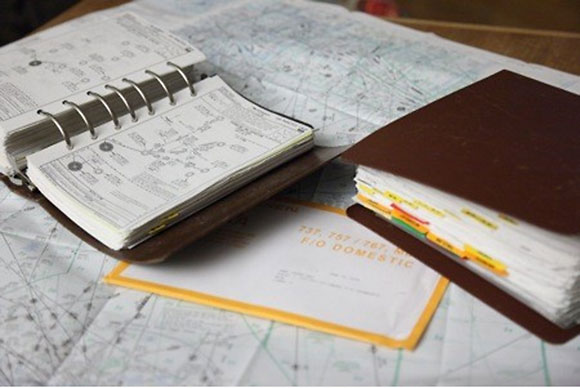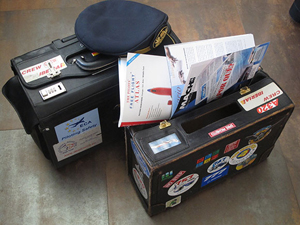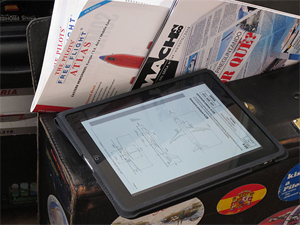
As a fan of contraptions of various sorts, I’m always curious about the stuff other people carry around, and every once in a while I’ve shared a few shots of this type on Flickr. That’s why I especially liked a Q&A I saw a while back called Plane Answers: What’s Really In a Pilot’s ‘Kitbag?’ Answered by Kent Wien, a Boeing 757/767 pilot for American Airlines, who lays out in eye-opening detail what he and his colleagues are carrying around in those briefcases we see them lugging onto and off of our flights.
Current AA regulations stipulate they must carry the following:
- Jeppesen Approach Plates These are two spiral-bound manuals weighing at least three pounds each – one for domestic destinations and another for overseas, whether Europe, South America, etc. – containing approach maps not just for customary landing airports but every alternate and emergency airport conceivable. The Jeppesen company mails updated charts to the pilots on a weekly basis.
- Aircraft Manuals Because if cars have them, planes certainly should too, right? Kent and his colleagues always carry with them their particular aircraft model’s operations manual, which is about the same size as one of the Jeppesen books, and lays out the details of the airplane’s systems and procedures. There’s also a “Quick Response Handbook” that covers emergency situations from smoke in the cabin to volcanic ash encounters, marked with orange or red tabs.
- Company Procedures and Regulations Manual As if the preceding weren’t reading enough, this tome covers matters such as flight planning, the responsibilities of crew members, regulations regarding airport approaches and landings, and even dress code minutiae such as color of socks – black being regulation but not blue. This manual also includes all applicable FAA regulations.
- Aircraft Specific Minimum Equipment List (aka MEL) As the name suggests, this document specifies the items that the airline and the FAA agree need to be functioning before an aircraft can fly, and if any one of them fails, a plane will be grounded until it is repaired. In the case of American, the captain is in possession of the 757 MEL, while the co-pilot (and relief pilot, if any), carry the MEL for the 767.
- Flashlight for whatever needs may arise.
- Spare eyeglasses or contact lenses if the pilot needs to wear corrective lenses.
In addition to all this, Kent carries a so-called Trip Book, which is optional but he says makes his life easier. It includes the Jeppesen approach charts for the airports he’s most regularly flying in a given month; the normal procedures checklist; an RNAV approach guide (RNAV being a backup navigation system); and a procedural reference guide in case computers are down as we prepare for departure.
And we’re not done yet! This bag also includes a headset with microphone (most pilots prefer to buy their own rather than use the ones supplied by the airlines), a compact camera, and often a bottle of water.
In recent years, Kent reports, American has been allowing its pilots to carry what it calls a Class 1 Electronic Flight Bag – basically a laptop (in Kent’s case a MacBook with a charger and extra battery), loaded with the MEL and company manuals in PDF format. So that allows a bit of space savings there.
 Knowing all this, I of course had to ask the pilot of an Iberia A320 what he carries in his kit bag – and was surprised to learn that there are no specific regulations on the matter.
Knowing all this, I of course had to ask the pilot of an Iberia A320 what he carries in his kit bag – and was surprised to learn that there are no specific regulations on the matter.
This is due basically to the fact that the aircraft manuals and navigation charts are always onboard, as it is the responsibility of the maintenance crew to keep them current. Also aboard at all times is the aircraft’s Green Book, which contains flight records and accumulated hours, as well as the flight records, where details on each flight are noted, and so forth.
The rest is up to each individual pilot; in the case of the chap I spoke with, that usually includes the following:
- Replacement eyeglasses, one regular pair and one pair of sunglasses, both with prescription lenses.
- Reflective vest.
- Uniform cap.
- Copy of The Pilots’ Free Flight Atlas.
- Pens (lots of them, he admits) and a fluorescent marker.
- Flashlight.
- One or more magazines (often about aviation, such as Fly News or Airliner World).
- Personal care kit which among other things includes skin lotion (as airline cabin air tends to dry out skin), aspirin, cold remedy, etc.
- Tea bags (he declares himself fed up with lousy coffee at some of the places he has to fly to), a couple of chocolates or bag of nuts, or perhaps on occasion a more substantial bit of food such as a sandwich.
 On top of all that, our pilot, who’s also a photography and planespotting buff, takes along a Canon XTi (Canon EOS 400D), with 75-300mm and 24-100mm lenses.
On top of all that, our pilot, who’s also a photography and planespotting buff, takes along a Canon XTi (Canon EOS 400D), with 75-300mm and 24-100mm lenses.
Finally, one tool he considers absolutely essential is an iPad loaded with all the aircraft and company manuals and bulletins, as well as relevant documents from bodies such as the ICAO (International Civil Aviation Organisation) and IFALPA (International Federation of Air Line Pilots’ Associations); other colleagues opt to carry these on laptops.
Naturally, this iPad also has plenty of non-work apps and programs, too, such as music and movies for layovers or flights he takes as a passenger rather than a pilot.
Whew! And I thought I lugged a lot of stuff around…

